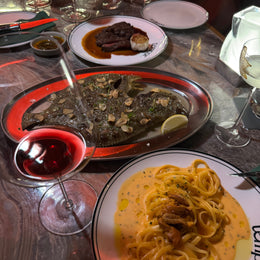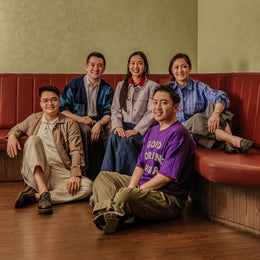
An air of calm and anticipation filled the warmly lit function room. The masterclass had just started, but the room wasn’t quite full yet. Those present sat behind rows of long tables covered with black cloth, each attendee provided with a neatly arranged flight of six enticing drams in Glencairns.
Paul Wang, Keeper of the Quaich and Asia Regional Sales Manager for Douglas Laing, stood in front of the class. He wore a white polo shirt, French-tucked into a pair of denim jeans matched with gray sneakers. Paul’s stance and manner of speaking exuded a character of quiet confidence; it was as if he didn’t feel the need to make a loud impression yet was fully aware of his expertise. He seemed eager, too, having just finalized his presentation and ready to share the story behind Douglas Laing’s Remarkable Regional Malts.
While I’m certain that for many, if not most, of the attendees, the most engaging segment of Paul’s class was when he talked about the whiskies in the flight, it was his discussion of the history of independent bottlers in Scotland that captured my attention. He explained the practice of independent bottling emerged as a way for farmers to earn from the whisky they distilled using their excess grain stock and as a way for private storeowners to create personal brands built on the consistencies made possible by blending. These circumstances, according to Paul, made one fact clear: “There’s a necessity to independent bottlings.”
Suddenly, I felt a wave of hyperawareness. I realized that I wasn’t just at home, sitting in front of a screen. Instead, I was drinking whisky with others who were sitting at arm’s length. I was examining a dram while the person speaking about it was only a couple of meters away, making it easy for everyone to observe his movements and hear the timbre of his voice. Every now and then, the man next to me would whisper to give his unsolicited comments or ask for mine. The clinks of glasses were audible, as were the small reactions that followed each dram. This was real. I was finally at a live whisky event since the start of the COVID-19 pandemic. These flows of awareness transplanted Paul’s point within my mind, wresting his idea from the genesis of independent bottling and firmly situating it in the physical concreteness of that moment. I wondered: Are in-person spirits events like this still necessary?


The last physical spirits event I attended was certainly memorable, not only for its timing but for its raucousness and spontaneity. It was an Amrut whisky tasting at a local bar. After we finished what was left of the sample bottles, a friend and I, on impulse, merrily staggered toward a nearby liquor store. We each bought a bottle of bourbon that one of the other attendees waxed lyrical about – and we kept our bottles in brown paper bags, discreetly sipping from them while munching on fries at a McDonald’s. It was the day before the government announced the lockdown.
Afterward, spirits events took on a different character: laptop screens, sample kits, courier deliveries, and online quizzes. Here in the Philippines, the emergence of the e-numan signaled this shift (the term is a clever amalgamation of “electronic” and the Filipino word inuman, which translates to “drinking session”). It took a while to get started, but once brands and distributors became familiar with the infrastructure, online spirits events were on full force.
There was an initial charm to it, though. For a small fee, in large part due to the absence of the need to pay for venues and equipment, enthusiasts can sit comfortably in front of their gadgets or computers, perhaps in their pambahay (a Filipino word referring to the kind of clothes that are typically worn when at home), and listen to a presentation as they enjoy the set of samples that have been delivered straight to them. There was no longer the need to experience traffic, gas prices, or the inconveniences of big crowds and unlucky seats at venues. Here, all spots are front seats, and the speakers are as esteemed as they come. Without the online setup, spirits enthusiasts here in the Philippines would not have had the chance to listen to individuals such as Compass Box Whiskymaker Jill Boyd, Global Rum Ambassador Ian Burrell, or Glenfarclas Director of Sales George Grant. New opportunities for events also emerged. For instance, Dawn Davies, The Whiskey Exchange’s Head Buyer, and Mitch Wilson, the Global Brand Ambassador of Black Tot Rum, hosted a 24-hour rum festival on YouTube that featured an impressive lineup of guests and speakers. In addition, the wealth of spirits events was no longer contained solely in the memories of those who were present, for events were often recorded and available online. Brands were able to reach markets that those brands would otherwise not have the budget to reach, and distilleries were able to virtually open their doors to visitors who would otherwise not have been capable of physically dropping by.
One after another, online events kept coming, and people relished in the events’ allure and accessibility. But this wouldn’t last forever. The pandemic remained, and slowly, the drawbacks of those online spirits events were exposed. Many brand ambassadors felt unmotivated, showing less of the fire and energy they typically exuded. Organizing and sending out sample sets, facilitating online quizzes, and joining a string of video calls became dreadful and unrewarding work. According to some brand representatives that I got to talk to, many producers realized that online events weren’t as profitable as they’d hoped; they said that it wasn’t as easy to build brand identities and convince consumers to make purchases. Everyone grew tired of their homes, and when some countries began to transition into the “new normal,” producers and consumers were eager to go out. Online spirits events slowly lost their luster.

The first evening of Whisky Live Philippines 2022 felt like a renaissance.
The doors of the hotel grand ballroom were open earlier than the listed start time. There were barely any attendees yet, possibly owing to the traffic and the tail end of the rainy season in November, but the energy was already electric. Some exhibitors were lining up bottles and fixing up their booths. Others were reviewing cheat sheets, making sure that they knew how old each whisky was or what casks were used for maturation – of course, those were the details that most people tended to care about. Bartenders were occupied with mise en place, readying themselves to make cocktails to showcase the spirits being presented. Members of the media, with their SLRs and gimbal-stabilized video cameras, systematically went through the booths to capture content. The aisles were almost bare, and the chatter was still relatively low, limited to those who knew each other and wanted to catch up before the event got started.


By the middle of the evening, it was a maelstrom of movement that was undercut by excitement and fervor. This time, the aisles were full with throngs of attendees, healthily loosened up by the magic of alcohol’s buzz. People shuffled from one booth to the next, music and lights emanated from a small stage up front, and private classes took place in separate function rooms. I told myself that my goal during that first day would be to just try out the brands I haven’t experienced yet, and for the most part, I succeeded. Exhibitors were eager to talk about the brands they represented, and while there were disappointing moments when some didn’t understand their brands and spirits well enough, the personal interactions were nonetheless gratifying. The conversations were dynamic, shifting from the brands, to the uniqueness of each expression, and even to the general state of the industry. Needless to say, there was always another expression to try or revisit in each booth or the next.


The second evening was not much different. As if serving as a reminder that the opposite was impossible, the enthusiasm remained rampant, the warm lights were still inviting, and the aromas from cocktails and high-abv spirits were still vibrant. This time, I wanted to keep exploring but focus more on helping introduce some friends to the different brands and categories. The market’s growth made this so easy to do; like the first evening, there wasn’t just whisky. There was gin, beer, and much more rum. The floor plan was littered with spaces occupied by independent bottlers and other small brands that deserved a space within the discourse dominated by the big monopolies. As the evening progressed, my friends and I gravitated toward the booths whose spirits we enjoyed and debated about which bottles we’d spend on. Sometimes, we’d go to booths of local bars to buy individual drams, too. It was all a blissful blur. Similar to the previous day, the evening ended with a stroll through the chilly evening weather in the city, gushing over the event before helping each other find a way home.



I had forgotten what it meant and how it felt to enjoy spirits with others in person. There is a certain richness to it, making it a profound sensorial experience that can never be translated through screens and scheduled video calls. I was reminded of how well body language and eye contact could freely communicate and elevate aromas and flavors. I was reminded that this hobby is full of joy, concentrated in small moments like when I encounter the subjectivities of others or when I witness that split second when people fall in love with what they are drinking. Personal interactions constitute the act of celebrating a common hobby, and that hobby becomes most welcoming – most nourishing – when celebrated in person. Paul was right; there’s a necessity to it, indeed.

The Brown Dram
A Filipino living in Metro Manila, Jigs is a whisky and rum enthusiast. His passion for spirits has led him to develop interests in photography and, now, writing. Reach him and check out his work on Instagram @thebrowndram!







